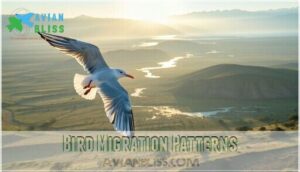This site is supported by our readers. We may earn a commission, at no cost to you, if you purchase through links.

Some species, like the Arctic Tern, travel over 40,000 miles annually, chasing endless summers.
Birds migrate for food, breeding, and to escape harsh weather, using incredible navigation tools like the stars, Earth’s magnetic field, and even familiar landmarks.
Migration patterns vary—some birds take short hops, while others, like the bar-tailed godwit, fly nonstop for thousands of miles.
But it’s not all smooth soaring; they face threats like storms, predators, and habitat loss.
These journeys highlight both their resilience and the delicate balance of ecosystems.
Curious about record-breaking migrations? The stories will amaze you.
Table Of Contents
- Key Takeaways
- Bird Migration Basics
- Why Birds Migrate
- Bird Migration Patterns
- Navigation Methods
- Record Breaking Migrations
- Migration Challenges
- Frequently Asked Questions (FAQs)
- What are some interesting facts about bird migration?
- What are some fun facts about migration?
- What is another reason that birds have migration patterns?
- What is bird migration?
- Why do migratory birds migrate?
- How many birds migrate a year?
- How do birds know when it’s time to migrate?
- What are some interesting facts about birds migration?
- What are the migration patterns of birds?
- What bird has the longest migratory pattern?
- Conclusion
Key Takeaways
- You’ll witness incredible endurance during bird migration, with species like the Arctic Tern traveling over 49,700 miles annually between poles, chasing endless summers rather than simply escaping cold weather.
- You’ll find that birds don’t just rely on instinct—they navigate using sophisticated methods including celestial cues, Earth’s magnetic field, visual landmarks, and innate direction sense built into their genetic makeup.
- You’ll see various migration patterns adapted to different species’ needs, from short-distance travelers moving just tens of miles to record-breakers like the Bar-tailed Godwit that flies 7,000 miles non-stop from Alaska to New Zealand.
- You’ll notice birds face increasing challenges during migration, including predation, harsh weather, light pollution, and critical habitat loss that threatens their carefully evolved migration routes and stopover sites.
Bird Migration Basics
You’ll witness birds traveling over 49,700 miles annually as they follow Earth’s magnetic field and celestial guides in search of abundant food, not just to escape cold temperatures.
Birds embark on epic 49,700-mile journeys, guided by magnetic fields and stars, chasing food and survival across the globe.
These remarkable journeys occur across varying distances, with birds storing fat reserves through hyperphagia before setting out on flights that can reach altitudes of 37,000 feet or maintain speeds of 60 mph for thousands of continuous miles, showcasing their ability to cover long distances at significant speeds.
Definition and Explanation
Witnessing bird migration means observing one of nature’s most remarkable journeys. Bird migration is the seasonal movement of birds between breeding and non-breeding areas, triggered by changes in food availability, daylight hours, and temperature.
This evolutionary adaptation helps birds survive by relocating to resource-rich environments. Birds undertake these journeys primarily to secure suitable nesting sites.
- Imagine thousands of geese forming perfect V-formations against a sunset sky
- Picture tiny warblers crossing vast oceans overnight, guided only by stars
- Visualize arctic terns flying from pole to pole, witnessing two summers each year
Types of Migration
Now that you understand what bird migration is, let’s explore the various ways birds move around.
Bird migration patterns fall into several distinct categories, each representing different strategies birds have evolved to survive.
| Migration Type | Characteristics | Example Species |
|---|---|---|
| Resident Birds | Stay in one location year-round | Northern Cardinal |
| Partial Migration | Some populations migrate, others don’t | American Robin |
| Altitudinal Migration | Move up and down elevations | Mountain Quail |
| Irruptive Migration | Irregular movements based on food availability | Snowy Owl |
You’ll find short-distance migrants travel within continents, medium-distance migrants cross small water bodies, while long-distance migration can span continents.
Leapfrog migration occurs when northern populations fly farther south than their southern counterparts.
Importance of Migration
Migration serves as nature’s essential heartbeat, connecting ecosystems worldwide through bird movements.
You’ll find that bird migration patterns contribute substantially to ecosystem health by distributing seeds, controlling pests, and maintaining genetic diversity across continents.
These journeys aren’t just fascinating—they’re evolutionary advantages that guarantee population dynamics remain balanced.
Without this global connectivity, many habitats would collapse, and bird migration conservation efforts protect not just birds, but the intricate web of life they help sustain, which is crucial for maintaining a healthy ecosystem.
Why Birds Migrate
You’ll be surprised to learn that birds don’t migrate primarily to escape cold temperatures, but rather to follow food availability throughout the seasons.
As northern breeding grounds lose their abundant insects and plants in fall, birds must travel to regions where resources remain plentiful, making their epic journeys a matter of survival rather than comfort.
Food and Shelter
Food drives birds’ epic journeys more than anything else. You’ll find that birds follow a buffet across continents, not simply fleeing cold weather.
During migration, birds rely on:
- Predictable stopover sites for refueling after depleting fat reserves
- Specific habitats matching their foraging strategies to maximize energy intake
- Areas with minimal resource competition from other species
At these critical stopover sites, insect availability often determines how long birds will stay before continuing their remarkable journeys. Supplementing their diet with high-energy seeds can further aid their travels, providing a much-needed energy intake.
Breeding and Nesting
Beyond just finding food, birds travel to secure ideal breeding grounds where nesting success rates are higher.
You’ll find that northern habitats offer longer daylight hours for feeding chicks and reduced predator threats.
Migration timing is precisely synchronized with breeding seasons, triggered by changing day length and genetic makeup.
Birds carefully select habitats with abundant nesting materials and food availability, ensuring higher clutch sizes and better parental care opportunities, which is crucial for their nesting success.
Escaping Harsh Weather
While birds build their nests for reproduction, they’re also keeping an eye on the weather forecast. Contrary to popular belief, cold tolerance isn’t the primary driver of seasonal bird migration—it’s about avoiding resource scarcity that comes with harsh conditions.
Weather patterns substantially impact migration timing:
- Arctic species flee before winter storms make feeding impossible
- Tropical birds shift habitats during monsoon seasons
- Climate change has altered traditional migration schedules
- Birds often depart before storms arrive, sensing barometric pressure changes
- Some species have developed migration challenges as their winter destinations warm
Bird Migration Patterns
You’ll find birds exhibit three distinct migration patterns—short, medium, and long-distance journeys—each suited to their specific survival needs and evolutionary adaptations.
From mountain-dwelling species that descend to lower elevations seasonally to remarkable travelers like the Arctic tern that flies from pole to pole, these patterns showcase nature’s ingenious solutions to the challenge of resource availability.
Short-Distance Migration
Not all feathered travelers need to cross continents.
Short-distance migrants like robins and waxwings typically journey just tens or hundreds of miles, tracking local resources as seasons change. You’ll notice these birds adapting readily to varying conditions—moving between elevations (altitudinal migration) or following food sources.
Their seasonal bird migration developed from simple survival needs. Notably, climate change has affected their migratory patterns; they’re now arriving about 13 days earlier than they did in the late 20th century, which is a significant change in their migratory patterns and has an impact on their overall survival needs.
Medium-Distance Migration
While short-distance migrants make local movements, medium-distance migrants venture further but still stay within continental boundaries.
These travelers journey a few hundred miles following regional flyways in somewhat irregular north-to-south patterns.
Medium-distance migrants demonstrate fascinating adaptive strategies:
- They’re often mistakenly identified as year-round birds, despite their seasonal movements
- They track resources across moderate migration distances
- Eastern Bluebirds exemplify this pattern, adjusting their migratory patterns in response to climate impacts
Though not as dramatic as long-distance migration, these birds’ journeys showcase remarkable navigation abilities within familiar territory, and are a testament to their ability to adapt to their environment.
Long-Distance Migration
Long-distance migration showcases Nature’s ultimate endurance champions, with birds traveling thousands of miles twice yearly.
You’ll be amazed by their non-stop flights across continents and oceans.
| Bird Species | Migration Distance | Route | Remarkable Feat | Navigation Strategy |
|---|---|---|---|---|
| Arctic Tern | 44,000 miles | Arctic to Antarctic | Longest migration | Celestial cues |
| Blackpoll Warbler | 2,300 miles | North America to South America | 86-hour non-stop flight | Magnetic fields |
| Bar-tailed Godwit | 7,000 miles | Alaska to New Zealand | Longest non-stop flight | Visual landmarks |
| Pectoral Sandpiper | 18,000+ miles | Arctic to Southern Hemisphere | Multiple stopover sites | Mixed methods |
| Short-tailed Shearwater | 27,000 miles | Australia to North Pacific | Oceanic migration | Olfactory cues |
Examples of Migration Patterns
While some species undertake extraordinary long-distance journeys, you’ll find fascinating flyway variations across the avian world.
Arctic terns complete a pole-to-pole round trip annually, while red knots travel from Arctic tundra to southern hemisphere beaches.
Purple martins demonstrate classic long distance migration between the Americas, and Eurasian wigeons establish regular migration routes across Europe and Africa.
You can visualize these routes with a detailed migration pattern.
Perhaps most impressive are bar-tailed godwits, making non-stop flights from Alaska to New Zealand—a true marvel of migratory bird species.
Navigation Methods
You’ll be amazed at how birds navigate thousands of miles without GPS, using the sun, stars, Earth’s magnetic field, and landmarks to guide their journeys.
While humans might get lost driving to a new city without technology, these feathered travelers can find their way across continents and oceans using multiple navigation systems working in precise coordination.
Celestial Navigation
During night migrations, birds rely on celestial navigation to chart their course across vast distances.
They’ve developed remarkable navigational skills using star patterns and lunar influence as their roadmap in the sky.
- Birds memorize star positions relative to Polaris (the North Star) for directional guidance
- Solar cues help calibrate their internal compass during dawn and dusk
- Celestial orientation develops in young birds before their first migration
- Light pollution disrupts this natural navigation system, confusing migrating birds
Interestingly, some enthusiasts explore bird star navigation as a hobby.
Magnetic Field Navigation
Many birds possess a remarkable built-in compass that lets them detect Earth’s magnetic fields during migration.
This magnetoreception location typically resides in their beaks and eyes, allowing for precise navigation across vast distances.
| Magnetic Reception Type | Function | Bird Examples |
|---|---|---|
| Iron-based receptors | Detect field intensity | Pigeons, robins |
| Light-dependent proteins | Sense field direction | Thrushes, warblers |
| Quantum effects | Process magnetic signals | European robins |
| Geomagnetic intensity | Create "magnetic map" | Albatrosses, petrels |
| Trigeminal nerve | Transmit magnetic information | Homing pigeons |
You’d be amazed how these avian navigation systems work even on cloudy nights when stars aren’t visible.
You can even find products for magnetoreception to study this phenomenon of magnetic fields and navigation.
Visual Cues and Landmarks
Birds are masters of migration navigation strategies, using landmarks like rivers, mountains, and even urban landscapes for route memory.
Coastal navigation helps seabirds trace migration routes along shorelines, while habitat mapping guides others through forests or open plains.
These avian navigation skills are so sharp that some species return to the same tree year after year—talk about impressive migration route mapping!
Some birds even utilize Earth’s magnetic field as a navigational tool.
Innate Sense of Direction
While landmarks guide experienced travelers, young birds often find their way without ever having made the journey before.
This innate sense of direction comes built into their genetic makeup, allowing first-year birds to navigate independently to destinations they’ve never seen.
Bird navigation strategies include:
- Genetic programming that creates mental maps of migration routes
- Instinctual responses to magnetic fields that function like an internal compass
- Imprinting factors that encode migration paths before hatching
You’d be amazed—many species complete their first-flight paths perfectly without any guidance from adults, using their innate sense of direction and instinctual responses to navigate.
Record Breaking Migrations
You’ll be amazed at the extraordinary feats birds accomplish during migration, with Arctic terns flying over 49,700 miles annually between the Arctic and Antarctic.
Bar-tailed godwits demonstrate remarkable endurance by flying nearly 7,000 miles non-stop, the longest recorded uninterrupted flight in the avian world.
Longest Migration Route
Just as birds rely on various navigation methods, some push these skills to their limits on the world’s longest migration routes.
Arctic Terns hold the incredible record, traveling 90,000 km annually between Greenland and Antarctica.
You’ll be amazed by the Bar-tailed Godwit’s journey—flying 13,560 km non-stop from Alaska to Tasmania in just 11 days.
These extreme distances showcase the remarkable endurance required for long-distance migration across established flyways.
Highest Altitude Reached
Soaring through the thin air of the Himalayas, Bar-headed Geese demonstrate remarkable altitude adaptations, flying at breathtaking heights over 23,000 feet near Mount Everest.
Their specialized physiology allows them to thrive where atmospheric conditions would limit other birds.
You’ll be amazed to learn a Ruppell’s Griffon Vulture holds the record for the highest bird flight ever, confirmed after a vulture plane strike at 37,000 feet—nearly 7 miles above Earth, showcasing its incredible ability to reach breathtaking heights!
Fastest Migration Speed
In the context of bird migration speeds, nature has engineered some truly remarkable aerial athletes.
The great snipe leads the pack, reaching an astonishing 90 km/h during its 4,200 km journey completed in just 36 hours—a marathon of sustained flight speed.
Five bird species with impressive migration speeds:
- Great Snipe – 90 km/h
- Eurasian Hobby – 100+ km/h
- Red-necked Phalarope – 60 km/h
- Northern Wheatear – 50 km/h
- Swainson’s Hawk – 70 km/h
Examples of Record-Breaking Migrations
In the context of speed demons in the sky, these migrations represent nature’s ultimate marathons.
You’ll find the Arctic Tern’s 90,000 km journey tops the charts as the longest migration route.
The Bar-tailed Godwit impresses with its 13,560 km non-stop flight, while Bar-headed Geese navigate the Himalayas at 23,000 feet.
Great Snipes achieve remarkable speeds of 90 km/h during their long-distance migration across continents, showcasing their ability to cover vast distances at remarkable speeds.
Migration Challenges
You’ll face numerous obstacles during your migratory journey, from deadly predators and extreme weather conditions to human-created hazards like light pollution and habitat destruction.
While birds have evolved remarkable adaptations to overcome these challenges, the combined threats of climate change and human development have made these epic travels increasingly perilous for many species, highlighting the need to address human development impacts.
Predation and Hunting
Facing predators during migration creates one of the most significant survival challenges for birds.
You’ll notice how predator avoidance influences migration timing, with many species traveling at night to reduce visibility.
Hawks, falcons, and other hunters strategically position themselves along flyways, increasing prey vulnerability.
Human hunting, particularly in Mediterranean countries where songbirds are considered delicacies, compounds these migration hazards.
The combined pressure from natural predators and habitat impact can dramatically decrease migration success rates.
Harsh Weather Conditions
How do migrating birds survive when Mother Nature unleashes her fury? Weather presents formidable challenges during long journeys, often determining life or death outcomes.
- Storm impact can force birds off course, depleting precious energy reserves
- Temperature extremes and precipitation hazards create dangerous flying conditions
- Wind effects can either help birds conserve energy or completely derail migration timing
Climate change intensifies these migration hazards, creating increasingly unpredictable weather patterns that test birds’ remarkable survival adaptations. This forces birds to endure even more challenging conditions, making their journey a true test of remarkable survival.
Human Activities and Pollution
Beyond weather’s fury, the human footprint creates even more complex challenges for bird migration.
You’ll notice our activities introduce numerous obstacles that weren’t present a century ago.
The loss of key stopover locations highlights the need for habitat conservation strategies.
| Human Factor | Impact on Bird Migration | Conservation Approach |
|---|---|---|
| Light Pollution | Disorientation of navigation systems | "Lights Out" programs |
| Chemical Pollution | Contamination of food and water sources | Reduced agricultural runoff |
| Plastic Waste | Physical injuries from ingestion | Beach cleanup initiatives |
| Industrial Structures | Fatal collisions during flight | Bird-friendly design standards |
| Climate Change | Disruption of migration timing | Carbon emission reduction |
The human footprint and its associated factors, such as light pollution, chemical pollution, plastic waste, industrial structures, and climate change, significantly impact bird migration patterns.
The table outlines specific conservation approaches for each factor, including "Lights Out" programs, reduced agricultural runoff, beach cleanup initiatives, bird-friendly design standards, and carbon emission reduction.
Habitat Loss and Fragmentation
While pollution creates immediate dangers, habitat loss represents a silent crisis for migrating birds.
You’ll find that deforestation, urban development, and agricultural expansion have destroyed or fragmented critical stopover sites.
More than one-third of the Americas’ 340 migratory species now face serious risks.
Without habitat corridors and conservation strategies, birds can’t rest or refuel during their journeys.
The effects of climate change only compound these problems, making bird conservation increasingly urgent.
Frequently Asked Questions (FAQs)
What are some interesting facts about bird migration?
While tiny birds cross vast oceans without stopping, Arctic terns fly the equivalent of three moon trips in their lifetime.
You’ll find that birds navigate using stars, Earth’s magnetic field, and even their sense of smell.
What are some fun facts about migration?
You’ll be amazed to learn that Arctic Terns fly over 49,700 miles annually between poles, experiencing two summers each year.
Some birds can detect Earth’s magnetic field to navigate their incredible journeys.
What is another reason that birds have migration patterns?
Ever wonder what drives birds beyond just finding food?
You’ll find that birds migrate to secure ideal breeding grounds with fewer predators, ensuring their offspring have the best chance at survival when they hatch.
What is bird migration?
Bird migration is your planet’s remarkable seasonal movement where birds travel between breeding and wintering grounds.
They’re driven by food availability, not just temperature, using the sun, stars, and Earth’s magnetic field to navigate, which is a key factor in their migration.
Why do migratory birds migrate?
You’ll find birds migrate primarily for food, not to escape cold temperatures.
They’re seeking abundant resources for survival and breeding, following seasonal patterns that guarantee they can access plentiful insects, plants, and suitable nesting locations, which is crucial for their survival.
How many birds migrate a year?
You’ll witness roughly 4 billion birds migrating in North America alone each year, with global numbers reaching nearly 50 billion. That’s approximately 40% of all bird species taking to the skies annually.
How do birds know when it’s time to migrate?
Like clockwork in nature’s grand theater, birds sense migration time through changing daylight hours.
You’ll notice they’re programmed to respond to these photoperiod shifts, which trigger hormonal changes signaling it’s time to move.
What are some interesting facts about birds migration?
You’ll be amazed that Arctic terns fly over 49,700 miles annually between poles.
Some birds double their weight before migrating, while bar-tailed godwits can fly 7,000 miles non-stop—the longest uninterrupted flight ever recorded.
What are the migration patterns of birds?
You’ll find birds migrate in diverse patterns – permanent residents stay put, while others travel short, medium, or long distances seasonally.
They’re following food availability, using the sun, stars, and Earth’s magnetic field to navigate.
What bird has the longest migratory pattern?
The Arctic Tern holds the crown for longest migration, traveling 49,700 miles annually between the Arctic and Antarctic. You’ll find these incredible birds basically chasing summer year-round during their remarkable journeys.
Conclusion
Remarkably, just as our lives follow seasons of change, birds undertake epic migrations that showcase nature’s ingenuity.
The bird facts about their migration patterns we’ve explored reveal not just survival mechanisms, but evolutionary marvels refined over millennia.
You’re now equipped to appreciate these aerial marathons with informed wonder.
Whether you’re tracking backyard visitors or planning a birding expedition, you’ll view each feathered traveler as a symbol to life’s remarkable adaptability.
What migration will you witness next?
- https://unric.org/en/10-facts-about-migratory-birds/
- https://www.audubon.org/news/9-awesome-facts-about-bird-migration
- https://www.kaytee.com/learn-care/wild-bird/10-facts-about-migrating-birds
- https://www.allaboutbirds.org/news/the-basics-how-why-and-where-of-bird-migration/
- https://climate.nasa.gov/news/3201/climate-patterns-thousands-of-miles-away-affect-us-bird-migration/









